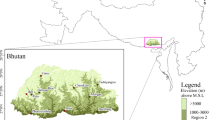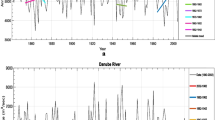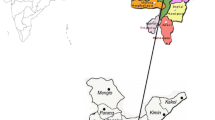Abstract
Rainfall variability is a key element in water resource management. There has been significant variability in rainfall in Arunachal Pradesh, with the state being in the highest rainfall zone in India. The present study attempts to investigate the annual rainfall trend along with the change points in the rainfall time series, considering more than a hundred years of data (1901–2002) in eleven districts of Arunachal Pradesh. First, a serial correlation test was conducted on the entire time-series data for the three districts to detect the serially independent time series, followed by the non-parametric Mann–Kendall test and Spearman’s rank correlation test to ascertain the presence of a statistically significant trend in hydrological climate variables. Sen’s slope method was applied to estimate the magnitude of the trend. Pre-whitening, trend free pre-whitening Mann–Kendall, and bias corrected pre-whitening, along with two variance correction approaches, are applied to the serially correlated data. All the districts under consideration show a decreasing trend in rainfall in the investigation over the years. A comparative study of the trend test method was also carried out. Further, to identify the trend change points in the time series, a sequential Mann–Kendall test is conducted. Assessing 100 years of time series data for the region makes the study unique of its kind and is likely to play a vital role in environmental policymaking. Furthermore, it will be helpful for water resource management, land use, land cover management, sustainable agricultural planning, and the overall socio-economic development of the region.

























Similar content being viewed by others
Data Availability
The datasets generated during and/or analyzed during the current study are available from the corresponding author upon reasonable request.
References
Touseef, M., Chen, L., Yang, K., & Chen, Y. (2020). Long-term rainfall trends and future projections over Xijiang River Basin, China. Advances in Meteorology. https://doi.org/10.1155/2020/6852148
Aznarez, C., Jimeno-Sáez, P., López-Ballesteros, A., Pacheco, J. P., & Senent-Aparicio, J. (2021). Analysing the impact of climate change on hydrological ecosystem services in Laguna del Sauce (Uruguay) using the swat model and remote sensing data. Remote Sensing, 13(10). https://doi.org/10.3390/rs13102014
Vano, J. A., Scott, M. J., Voisin, N., Stöckle, C. O., Hamlet, A. F., Mickelson, K. E., Elsner, M. M., & Lettenmaier, D. P. (2010). Climate change impacts on water management and irrigated agriculture in the Yakima River Basin, Washington, USA. Climate Change, 102(1–2), 287–317. https://doi.org/10.1007/s10584-010-9856-z
Valipour, M. (2012). Critical areas of Iran for agriculture water management according to the annual rainfall. European Journal of Scientific Research, 84(600), 608.
Sarma, B., Sarma, A. K., & Singh, V. P. (2013). Optimal ecological management practices (EMPs) for minimizing the impact of climate change and watershed degradation due to urbanization. Water Resources Management, 27(11), 4069–4082. https://doi.org/10.1007/s11269-013-0396-y
Ahmed, I. A., Shahfahad, Dutta, D. K., Baig, M. R. I., Roy, S. S, & Rahman, A. (2021). Implications of changes in temperature and precipitation on the discharge of Brahmaputra River in the urban watershed of Guwahati, India. Environmental Monitoring and Assessment, 193(8). https://doi.org/10.1007/s10661-021-09284-8
Ayamga, J., Pabi, O., Amisigo, B. A., Fosu-Mensah, B. Y., & Codjoe, S. N. A. (2021). Annual and intra-annual climate variability and change of the Volta Delta, Ghana. Environmental Monitoring and Assessment, 193(4). https://doi.org/10.1007/s10661-021-08986-3
Rahmat, S. N., Tarmizi, A. H. A., & Tukimat, N. N. A. (2021). Impacts of climate change on rainfall trends under RCP scenarios in Johor, Malaysia. https://doi.org/10.21203/rs.3.rs-673266/v1
Farhangi, M., Kholghi, M., & Chavoshian, S. A. (2016). Rainfall trend analysis of hydrological subbasins in western Iran. journal of irrigation and drainage engineering, 142(10), 05016004. https://doi.org/10.1061/(asce)ir.1943-4774.0001040
Gajbhiye, S., Meshram, C., Singh, S. K., Srivastava, P. K., & Islam, T. (2016). Precipitation trend analysis of Sindh River Basin, India from 102-year record (1901–2002). Atmospheric Science Letters, 17(1), 71–77. https://doi.org/10.1002/asl.602
IPCC. (2014). Climate change 2014: synthesis report. Contribution of Working Groups I, II, and III to the Fifth Assessment Report of the Intergovernmental Panel on Climate Change IPCC. Geneva, Switzerland.
Lanzante, J. R. (1996). Resistant, robust and nonparametric techniques for the analysis of climate data: Theory and examples, including applications to historical radiosonde station data. International Journal of Climatology, 16(11), 1197–1226.
Liu, D., Chen, X., Lian, Y., & Lou, Z. (2010). Impacts of climate change and human activities on surface runoff in the Dongjiang River Basin of China. Hydrological Processes, 24(11), 1487–1495. https://doi.org/10.1002/hyp.7609
Jain, S. K., Nayak, P. C., Singh, Y., Chandniha, & S. K. (2017). Trends in rainfall and peak flows for some river basins in India. In Current Science 112. https://doi.org/10.18520/cs/v112/i08/1712-1726
Jha, R. K., Kalita, P. K., & Cooke, R. A. (2021). Assessment of climatic parameters for future climate change in a major agricultural state in India. Climate, 9(7), https://doi.org/10.3390/cli9070111
Dabral, P. P., & Hangshing, L. (2017). Analysis of change point of rainfall and its trend in Doimukh (Itanagar), Arunachal Pradesh. Journal of Soil and Water Conservation, 16(4), 370–379. https://doi.org/10.5958/2455-7145.2017.00054.6
Mahato, L. L., Kumar, M., Suryavanshi, S., Singh, S. K., & Lal, D. (2021). Statistical investigation of long-term meteorological data to understand the variability in climate: A case study of Jharkhand. India. Environment. Development and Sustainability, 23(11), 16981–17002. https://doi.org/10.1007/s10668-021-01374-4
Kumar, V., Jain, S. K., & Singh, Y. (2010). Analysis of long-term rainfall trends in India. Hydrological Sciences Journal, 55(4), 484–496. https://doi.org/10.1080/02626667.2010.481373
Sreelash, K., Sharma, R. K., Gayathri, J. A., Upendra, B., Maya, K., & Padmalal, D. (2018). Impact of rainfall variability on river hydrology: A case study of Southern Western Ghats. India. Journal of the Geological Society of India, 92(18), 548–554. https://doi.org/10.1007/s12594-018-1065-9
Tiseo, I. (2021). Seasonal rainfall in Arunachal Pradesh India 2018. Water & Wastewater. https://www.statista.com/statistics/958548/india-seasonal-rainfall-in-arunachal-pradesh/
Chaplot, B. (2021). Prediction of rainfall time series using soft computing techniques. Environmental Monitoring and Assessment, 193(11). https://doi.org/10.1007/s10661-021-09388-1
Basistha, A., Arya, D. S., & Goel, N. K. (2009). Analysis of historical changes in the Indian Himalayas. International Journal of Climatology, 29(4), 555–572. https://doi.org/10.1002/joc.1706
Barua, S., Muttil, N., Ng, A. W. M., & Perera, B. J. C. (2013). Rainfall trend and its implications for water resource management within the Yarra River catchment. Australia. Hydrological Processes, 27(12), 1727–1738. https://doi.org/10.1002/hyp.9311
India Water Portal. (2021). Meteorological datasets. Accessed June 3, 2021. http://www.indiawaterportal.org/metdata
Tripathi, S. K., & Dubey, S. K. (2014). Trend analysis by Mann-Kendall test for precipitation and temperature for thirteen districts of Uttarakhand Yield Forecasting, Remote Sensing based Crop Insurance, Crop Damage Assessment View project FASAL programme of Ministry of Agriculture and Farmers Welfare View project. In Article in Journal of Agrometeorology. Retrieved: August 1, 2022. https://www.researchgate.net/publication/286452272
Pohlert, T. (2020). Nonparametric trend tests and change-point detection. Retrieved: August 1, 2022. https://cran.r-project.org/web/packages/trend/index.html
Gupta, S. K., Gupta, N., & Singh, V. P. (2021). Variable-sized cluster analysis for 3d pattern characterization of trends in precipitation and change-point detection. Journal of Hydrologic Engineering, 26(1), 04020056. https://doi.org/10.1061/(asce)he.1943-5584.0002010
Zhang, Z., Dehoff, A. D., & Pody, R. D. (2010). New approach to identify trend pattern of streamflow. Journal of Hydrologic Engineering, 15(3), 244–248. https://doi.org/10.1061/(ASCE)HE.1943-5584.0000179
Bisai, D., Chatterjee, S., Khan, A., & Barman, N. (2014). Application of sequential Mann-Kendall test for detection of approximate significant change point in surface air temperature for Kolkata weather observatory, West Bengal, India. International Journal of Current Research, 6, 5319–5324.
Forest Survey of India. (2019). India State of Forest Report 2019. Retrieved: August 1, 2022. http://fsi.nic.in/isfr2019/chapters/AP.pdf
Shivam, G., Goyal, M. K., & Sarma, A. K. (2019). Index-based study of future precipitation changes over Subansiri river catchment under changing climate. Journal of Environmental Informatics, 34(1), 1–14. https://doi.org/10.3808/jei.201700376
Zhao, J., & Wang, Z. (2020). Future trends of water resources and influences on agriculture in China. PLoS ONE, 15(4), https://doi.org/10.1371/journal.pone.0231671
Matlas, C. N. (1963). Autocorrelation of rainfall and streamflow minimums. Statistical Studies in Hydrology Geological Survey Professional paper., 434, B1–B9.
Mudelsee, M. (2001). Note on the bias in the estimation of the serial correlation coefficient of AR (1) processes. Statistical Papers, 42(4), 517–527.
Andrade, C. (2019). The P value and statistical significance: Misunderstandings, explanations, challenges, and alternatives. Indian Journal of Psychological Medicine, 41(3), 210–215. https://doi.org/10.4103/IJPSYM.IJPSYM_193_19
Mann, H. B. (1945). Nonparametric test against trend. Econometrica, 13(3), 245–249. https://doi.org/10.2307/1907187
Yue, S., Pilon, P., & Cavadias, G. (2002). Power of the Mann-Kendall and Spearman’s rho tests for detecting monotonic trends in hydrological series. Journal of Hydrology, 259(1–4), 254–271. https://doi.org/10.1016/S0022-1694(01)00594-7
Sen, P. K. (1968). Estimates of the regression coefficient based on Kendall’s tau*. Journal of the American Statistical Association, 63(324), 1379–1389.
Karpouzos, D., Kavalieratou, S., & Babajimopoulos, C. (2010). Trend analysis of precipitation data in Pieria Region (Greece). European Water, 30, 31–40.
Von Storch, H. (1995). Misuses of statistical analysis in climate research. In: von Storch H, Navarra A (eds) Analysis of climate variability: applications of statistical techniques. Springer, Berlin.
Hamed, K. H., & Rao, A. R. (1998). A modified Mann-Kendall trend test for autocorrelated data. Journal of Hydrology, 204(182), 196.
Yue, S., & Wang, C. (2004). The Mann-Kendall test modified by effective sample size to detect trend in serially correlated hydrological series. Water Resources Management, 18, 201–218.
Kahya, E., & Kalayc, S. (2004). Trend analysis of streamflow in Turkey. Journal of Hydrology, 289(1–4), 128–144. https://doi.org/10.1016/j.jhydrol.2003.11.006
Partal, T., & Kahya, E. (2006). Trend analysis in Turkish precipitation data. Hydrological Processes, 20, 2011–2026.
Pettitt, A. N. (1979). A nonparametric approach to the change-point problem. Applied Statistics, 28, 126–135.
Bagnato, L., Capitani, L. & Punzo, A. (2017). A diagram to detect serial dependencies: an application to transport time series. Quality & Quantity. 51. https://doi.org/10.1007/s11135-016-0426-y
Acknowledgements
The authors thankfully acknowledge the Department of Science and Technology, Ministry of Science and Technology, Government of India for providing financial support. Infrastructural support to carry out the investigation was provided by the North Eastern Regional Institute of Science and Technology, Arunachal Pradesh, India. The authors also acknowledge India Meteorological Department, Pune, India, and India Water Portal for providing the research data.
Funding
Funding for this research was received from the Department of Science and Technology, Government of India.
Author information
Authors and Affiliations
Contributions
Conceptualization, G.G. and R.K.P; methodology, G.G. and R.K.P; software, G.G.; validation, G.G. and R.K.P; formal analysis, G.G.; investigation, G.G. and R.K.P; resources, G.G. and R.K.P; data curation, G.G.; writing—original draft preparation, G.G.; writing—review and editing, R.K.P; visualization, G.G. and R.K.P; supervision, R.K.P; project administration, R.K.P.
Corresponding author
Ethics declarations
Ethical Approval
Not applicable.
Conflict of Interest
The authors declare no competing interests.
Additional information
Publisher's Note
Springer Nature remains neutral with regard to jurisdictional claims in published maps and institutional affiliations.
Supplementary Information
Below is the link to the electronic supplementary material.
Rights and permissions
Springer Nature or its licensor (e.g. a society or other partner) holds exclusive rights to this article under a publishing agreement with the author(s) or other rightsholder(s); author self-archiving of the accepted manuscript version of this article is solely governed by the terms of such publishing agreement and applicable law.
About this article
Cite this article
Goswami, G., Prasad, R.K. Trend Analysis of Rainfall Pattern in Arunachal Pradesh (India). Environ Model Assess 28, 1093–1125 (2023). https://doi.org/10.1007/s10666-023-09903-3
Received:
Accepted:
Published:
Issue Date:
DOI: https://doi.org/10.1007/s10666-023-09903-3




